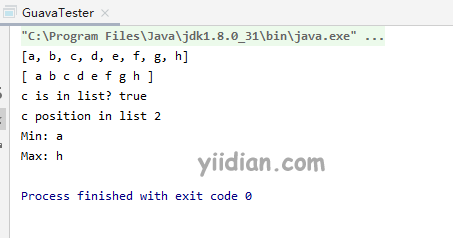Java Guava Chars类
1 什么是Guava Chars类
Chars 是原始类型 char 的实用程序类。
2 Guava Chars类的语法
@GwtCompatible(emulated = true)
public final class Chars
extends Object
3 Guava Chars类的方法
| 方法 | 描述 |
|---|---|
| static List<Character> asList(char... backingArray) | 返回由指定数组支持的固定大小列表,类似于 Arrays.asList(Object[])。 |
| static char checkedCast(long value) | 如果可能,返回等于 value 的 char 值。 |
| static int compare(char a, char b) | 比较两个指定的 char 值。 |
| static char[] concat(char[]... arrays) | 返回每个提供的数组中组合成单个数组的值。 |
| static boolean contains(char[] array, char target) | 如果目标作为数组中任何位置的元素存在,则返回 true。 |
| static char[] ensureCapacity(char[] array, int minLength, int padding) | 返回包含与数组相同的值的数组,但保证具有指定的最小长度。 |
| static char fromByteArray(byte[] bytes) | 返回其 big-endian 表示存储在字节的前 2 个字节中的 char 值;相当于 ByteBuffer.wrap(bytes).getChar()。 |
| static char fromBytes(byte b1, byte b2) | 以 big-endian 顺序返回其字节表示为给定 2 个字节的 char 值;相当于 Chars.fromByteArray(new byte[] {b1, b2})。 |
| static int hashCode(char value) | 返回值的哈希码;等于调用((Character) value).hashCode()的结果。 |
| static int indexOf(char[] array, char target) | 返回值目标在数组中第一次出现的索引。 |
| static int indexOf(char[] array, char[] target) | 返回指定目标在数组中第一次出现的起始位置,如果没有这样的出现,则返回 -1。 |
| static String join(String separator, char... array) | 返回一个字符串,其中包含由分隔符分隔的提供的字符值。 |
| static int lastIndexOf(char[] array, char target) | 返回值目标在数组中最后一次出现的索引。 |
| static Comparator<char[]> lexicographicalComparator() | 返回按字典顺序比较两个字符数组的比较器。 |
| static char max(char... array) | 返回数组中存在的最大值。 |
| static char min(char... array) | 返回数组中存在的最小值。 |
| static char saturatedCast(long value) | 返回值中最接近值的字符。 |
| static char[] toArray(Collection<Character> collection) | 将 Character 实例的集合复制到原始字符值的新数组中。 |
| static byte[] toByteArray(char value) | 返回 两个 元素字节数组中 value 的 big-endian 表示形式;相当于 ByteBuffer.allocate(2).putChar(value).array()。 |
5 Guava Chars类的例子
让我们看一个简单的Guava Chars类示例。
package com.yiidian;
import com.google.common.primitives.Chars;
import java.util.List;
public class GuavaTester {
public static void main(String args[]) {
GuavaTester tester = new GuavaTester();
tester.testChars();
}
private void testChars() {
char[] charArray = {'a','b','c','d','e','f','g','h'};
//convert array of primitives to array of objects
List<Character> objectArray = Chars.asList(charArray);
System.out.println(objectArray.toString());
//convert array of objects to array of primitives
charArray = Chars.toArray(objectArray);
System.out.print("[ ");
for(int i = 0; i< charArray.length ; i++) {
System.out.print(charArray[i] + " ");
}
System.out.println("]");
//check if element is present in the list of primitives or not
System.out.println("c is in list? " + Chars.contains(charArray, 'c'));
//return the index of element
System.out.println("c position in list " + Chars.indexOf(charArray, 'c'));
//Returns the minimum
System.out.println("Min: " + Chars.min(charArray));
//Returns the maximum
System.out.println("Max: " + Chars.max(charArray));
}
}
输出结果为:

热门文章
优秀文章


